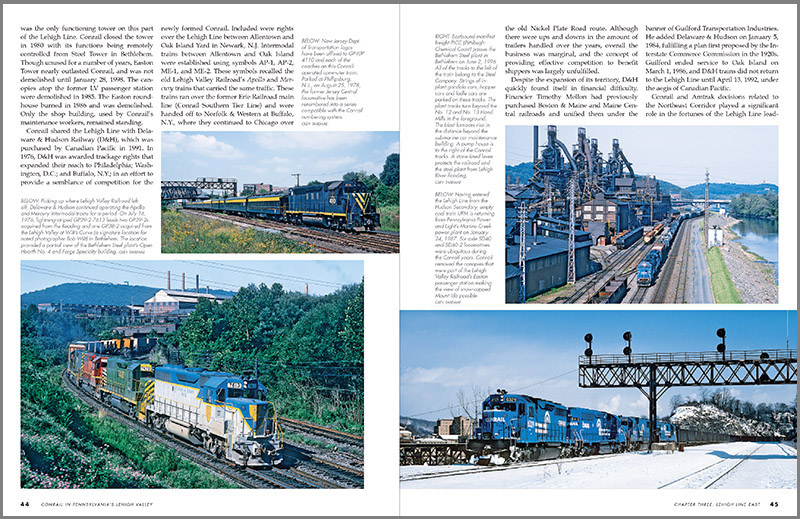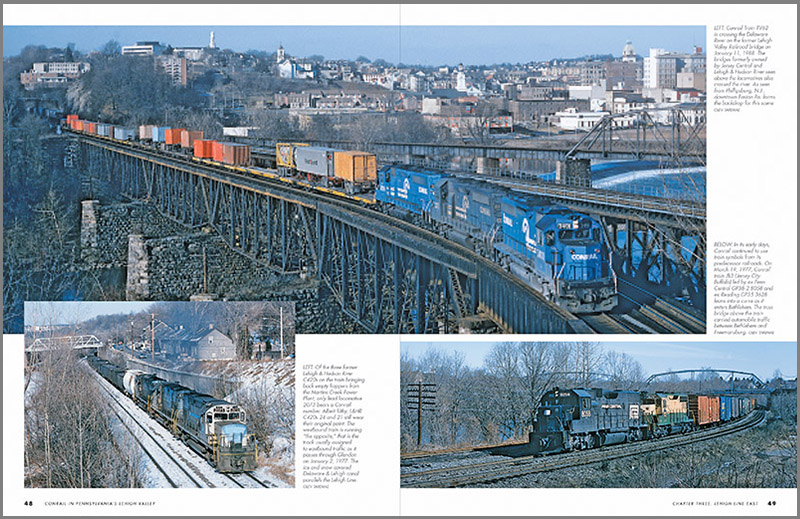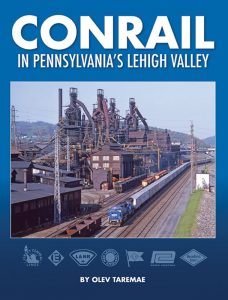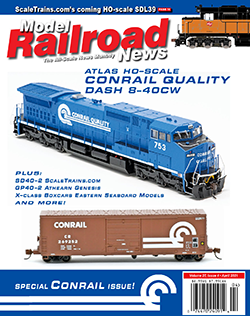Spanning the banks of its namesake river, Lehigh Valley in eastern Pennsylvania was a key contributor to the industrial history of the commonwealth and the United States as a whole, as far back as the nation’s adolescence in the early 19th century. As the need for raw material such as coal, ore, and limestone increased, to support the burgeoning iron and cement industries, a diverse transportation network rapidly evolved throughout the region, beginning with several canals, and culminating in what would ultimately become one of the densest and busiest rail systems on the east coast. While the industrial landscape of the Lehigh Valley was dominated by the mammoth Bethlehem Steel complex with its quartet of blast furnaces towering over the railroad and the river, with a patchwork of cement mills scattered across the horizon to the north, the area was home to a broad variety of other smaller manufacturing, including such household names as Crayola crayons and Mack trucks. At its zenith, the region generated sufficient business and rail traffic that both required and supported no less than 10 railroads: Reading Company; Lehigh Valley; Central Railroad of New Jersey; Pennsylvania Railroad (later Penn Central); Delaware, Lackawanna & Western (later Erie-Lackawanna); Lehigh & New England; Lehigh & Hudson River; Ironton Railroad; Northampton & Bath; and Philadelphia, Bethlehem & New England (Bethlehem Steel-owned, intra-plant railroad).
As the 20th century wore on, foreign manufacturing grew in the aftermath of World War II and began to make inroads against domestic production, which presented a new set of challenges for the industries in the Lehigh Valley. The railroads were not immune from these and other economic pressures; most readers are surely familiar with the ill-fated merger of the Pennsylvania and New York Central railroads to form Penn Central. The subsequent bankruptcy precipitated federal government action to create Conrail in 1976, which absorbed most of the railroads listed in the prior paragraph into “Big Blue.” While the initial years were challenging, rife with abandonment of superfluous lines, motive power struggles, and consolidation of operations into a coherent system, ultimately Conrail became a profitable rail powerhouse until its division and purchase by Norfolk Southern and CSX in 1999.

ABOVE: Olev Taremae demonstrates his high level of skill in railroad photography in this excellent hardcover title. The presentation of color images and layout design of this book make it a very enjoyable reading, viewing, and reference experience.
Through the two-plus decades from Conrail’s formation to its end, the Lehigh Valley remained a key hub and source of freight traffic for the railroad, and Olev Taremae’s new book from White River Productions, Conrail in Pennsylvania’s Lehigh Valley shines a new light on this part of east coast railroad history. Graduating from Bethlehem’s Lehigh University in 1972, with a career as a planner for the Lehigh Valley Planning Commission, Mr. Taremae was ideally positioned to witness and document the changes to the local railroad landscape brought on by the advent and growth of Conrail through the late 1990s. Conrail’s predecessor railroads and their activities in the Lehigh Valley have been presented in depth in other works, many of which have featured Mr. Taremae’s photographs. This new 126-page, full-color publication takes the unique approach of showcasing the passage of time in various locations throughout the region, from the early days of “patched out” fallen flag motive power and rolling stock to the later third-generation high-horsepower locomotives in their instantly recognizable blue paint and unmistakable “can opener” logo.
Conrail in Pennsylvania’s Lehigh Valley begins with a concise historical overview of each of the Conrail predecessor roads, accompanied by a selection of photos of each road. After this introduction, Mr. Taremae proceeds to document Conrail’s operations throughout the Lehigh Valley on a geographic basis, dedicating chapters to Allentown Yard, the original Lehigh Valley lines east and west of Allentown, former Jersey Central lines, and Reading Company. The various branch lines and industrial spurs in the area are collected into their own chapter, and the book concludes with a focus on Norfolk Southern’s arrival on the scene with the 1999 breakup of Conrail. While the many photographs published here are perfectly replicated, it must be stressed that this work is NOT simply a picture book. The captions for each photo are quite thorough, with operational notes and details that will be useful to Conrail modelers and enthusiasts alike. Furthermore, Mr. Taremae begins each “geographic” chapter with a thorough outline of the territory, its significance in the Conrail system in the area (and overall), as well as documenting the changes that took place throughout Conrail’s history. For example, the renewed importance of the former Lehigh Valley and Reading lines beginning in the late 1980s after all freight traffic was diverted off the Northeast Corridor in 1987 is touched upon. Changes in operational patterns, track alignments and facilities are also discussed; this information can be quite useful for modelers in accurately depicting a particular area at a particular time.

ABOVE: This region of the U.S. and the years documented in White River Productions’ recent Conrail in Pennsylvania’s Lehigh Valley are exciting times for railfans and useful for model railroading hobbyists. The collection of newly fallen flags into Conrail’s system makes this book a colorful delight.
While the information presented in the work is extensive and useful, it is the photographs that modelers will likely find most valuable. There are some rare gems here, like the shot of a former L&HR Alco C420 freshly repainted into Conrail blue with a “CR” on the long hood. Those favoring the early Conrail years will appreciate the diversity of fallen flag “patch job” locomotive consists, while those who prefer the “Big Blue” years will find plenty to their liking. The photos also provide many examples of evolving traffic through the years – from traditional rolling stock to intermodal cars. Not to be overlooked are the additional scenic details in the photos and how the landscape changed over time, from the mid-1970s to the 21st century. While the majority of the shots are Mr. Taremae’s own, he has also compiled a collection from several other notable east coast rail photographers, including the late Dave Augsburger, to whom the book is dedicated.
Conrail in Pennsylvania’s Lehigh Valley is a well-authored trip back in time through eastern Pennsylvania rail history from the late 1970s through the 2000s. Mr. Taremae has done an impressive job in documenting the formation and evolution of Conrail in the Lehigh Valley, and has curated a collection of photographs that illuminate the historical context he has provided. As a testament to the success of his effort, while I am a dyed-in-the-wool Reading Company historian and modeler, for whom rail history generally ends on March 31, 1976, I learned a great deal while reviewing this book, and it has spurred my interest in broadening my “rail horizons.” I encourage anyone with an interest in Conrail or its predecessors to consider adding this book to your collection.
White River Productions
shop.whiteriverproductions.com




